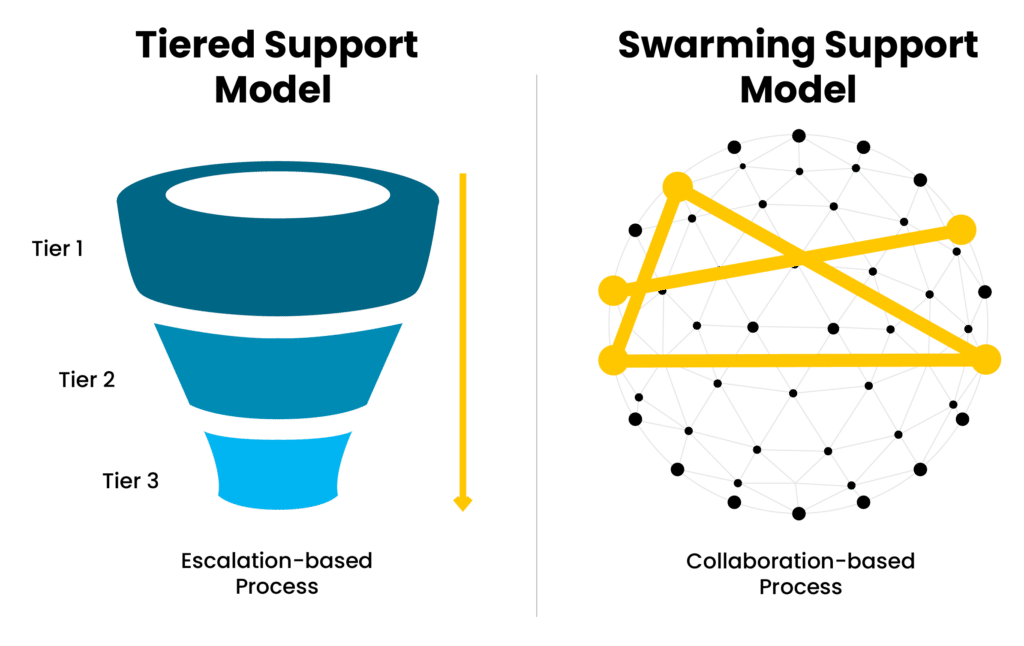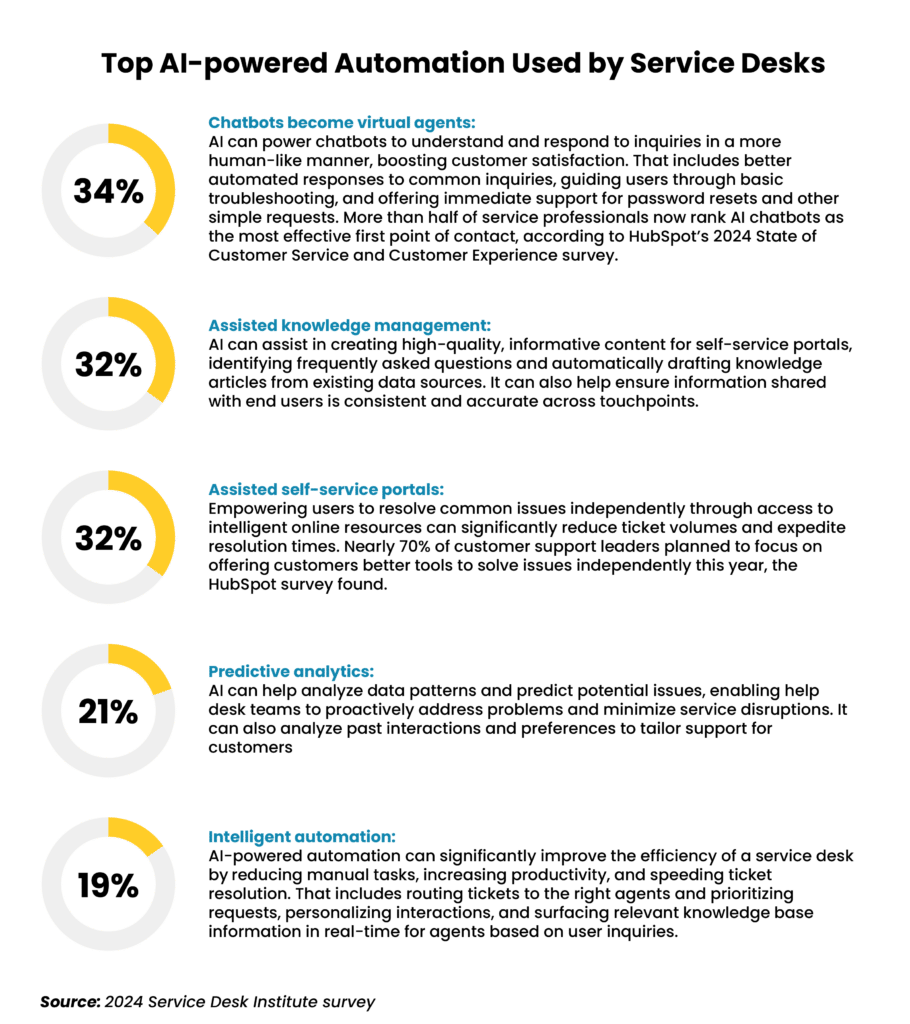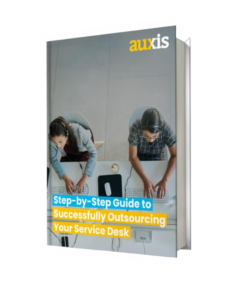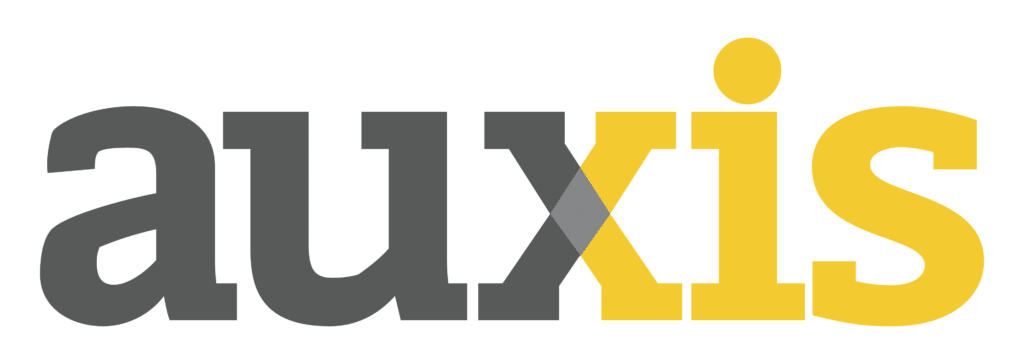In brief:
- Help desk is one of the most outsourced IT functions – with 50% of organizations already outsourcing at least part of their help desk.
- But while help desk outsourcing is #1 for reducing costs among IT functions, it ranks lower for service experience.
- Thoroughly assessing help desk providers before taking the plunge is key to improving end-user satisfaction and business outcomes.
- Six important qualities define top-notch IT service desk partners, including automation capabilities, physical proximity, and high Level 1 resolution rates.
Amid accelerating digital transformation, surging ticket volumes, and IT labor shortages, help desk outsourcing is growing by leaps and bounds. According to the 2023 IT Outsourcing Statistics Report by Computer Economics, help desk is now one of the most outsourced IT functions – with 50% of organizations already outsourcing their help desk function entirely or in part. That’s more than double 2021 levels.
However, while help desk outsourcing ranks #1 for reducing costs among IT functions, organizations are not as happy about the service experience. The same report found help desk outsourcing ranks near the bottom of IT functions performing the “same as” or “better” than what was achieved using in-house resources.
The takeaway: While help desk outsourcing is a proven solution for end-user support, assessing help desk service providers thoroughly is key to achieving a high-performing outsourced service desk.
Things that look attractive on the surface — like cheap Level 1 ticket servicing, for example — could hide ugly surprises, like poorly trained staff and frequent ticket escalation. This makes it important to find an outsourcer committed not just to excellent ticket servicing with minimal escalation, but also to prevention of issues and continuous improvement. Each time a ticket is reassigned, end-user happiness decreases by nearly eight points, and users lose an average of 1 hour and 42 minutes of work time per reassignment, the 10th Global IT Experience Benchmark from HappySignals found.
This blog examines the most important qualities to look for when selecting a help desk outsourcing provider.
What qualities define a top-notch IT service desk partner?
Critical attributes, from pricing models to automation capabilities, often vary among service providers. But even seemingly small differences can impact the experience of end-users and customers, as well as general business outcomes.
1. Well-structured service tiers and flexible support models
Quality outsourcing providers are process-dependent – organizing and escalating tickets through repeatable processes, well-structured organizations, and clearly defined service tiers. Beware outsourcers who promise to service three or more tiers outside your organization. The case may be that service at Level 1 is rather limited, and tickets tend to escalate rapidly to Levels 2 and 3, stretching resolution times and costs.
A better model is one where the outsourcer starts with Level 0 support, speeding resolution with user-retrievable information and self-support powered by an AI-based self-service portal that requires zero agent interaction. Level 1 teams should be able to solve 80% of issues, fulfilling service requests for known problems like access privileges or usage issues by following documented standard operating procedures (SOPs) or scripts.
More complex issues should be escalated to Levels 2 and 3, where the outsourcer, the client, or sometimes a third party can be responsible for fixing them, depending upon contract terms.
Your organization should also have the option to choose between the tiered support model and an intelligent swarming support model, based on what works better for business requirements. While tiered support involves well-defined escalation paths and issue hand-offs, intelligent swarming solves complex service cases or major incidents through a collaborative effort between the support team and experts from different organizational teams.
Offering both models maximizes the effectiveness of IT support, providing the flexibility to tailor the service approach based on the unique and evolving needs of organizations.

2. High resolution rates
Looking closely at resolution rates is critically important when choosing a help desk outsourcer. No matter how many attractive features a provider may have, none can move the needle if they don’t support the help desk’s end goal of resolving a large volume of tickets effectively within the time frame agreed upon by the client and outsourcer.
Level 1 resolution is the name of the help desk game. Organizations should make it a point to demand cost breakdowns for every support level from their potential help desk partner, avoiding sticker shock later from hidden costs.
Some outsourcing providers tout low Level 1 support prices to attract customers, only to later saddle them with higher costs for Level 2 and 3 service and high escalation rates.
Even in cases where a provider highlights high Level 1 resolution, this may conceal the fact that Level 1 support is confined to easy-to-fix issues. Clients may mistakenly believe that most tickets will be resolved at that level, but then find tickets – and costs – creeping upwards, even for tasks of moderate difficulty. Clearly defining what types of issues are covered at Levels 1, 2, and so on is key to effective service.
Companies should look for an outsourcing provider that achieves high overall resolution rates and excellent Level 1 service supported by well-documented procedures, a robust knowledge base, technical expertise, AI and automation capabilities that support rapid resolution, clear understanding of ticket prioritization, etc. Only then can an organization determine if a provider’s services at each tier will cover a big enough, or difficult enough, batch of service tickets to justify the cost.
3. Proven automation and AI capabilities
Automation, enhanced by next-generation technologies such as AI, can go a long way in elevating the customer experience that a service desk can provide by making IT support teams more effective, managing their workloads more efficiently, and resolving tickets faster.
Self-service portals, automated ticketing systems, routing tickets to the right agents and prioritizing support requests, password reset automation, and other automation initiatives contribute to increased efficiency, faster issue resolution, enhanced user satisfaction, and a more proactive and responsive service desk.
Automation is helping companies solve 80% of tickets in the first interaction for tasks like password reset, ensuring most high-volume, frequently reported issues are resolved between Levels 0 and 1, Freshservice’s 2023 IT Service Management Benchmark Report found. Resolution times are also down by about 23% through automation of tasks like password reset.
AI can help further elevate the service desk experience. AI can assist in creating high-quality, informative content for self-service portals, identifying frequently asked questions and automatically drafting knowledge articles from existing data sources, empowering users to resolve common issues independently.
Particularly with the advent of Generative AI, chatbots can now serve as virtual agents, understanding and responding to common inquiries in a more human-like manner, boosting customer satisfaction and offering immediate support for simple requests. Bots help IT teams provide quick resolutions to recurring issues, while also independently resolving nearly half (46%) of tickets raised, the Freshservice report found.
Businesses should research and ask questions about the automation capabilities of providers they are considering if they are looking to deliver a modernized service desk experience to end users.

4. Overall customer satisfaction
Several factors contribute to high service desk satisfaction:
- Service levels. Do not rely on “good faith” in service delivery. Companies that make this mistake may find their provider cannot or will not fix critical issues that it once intimated that it would, punting them unexpectedly back to your internal team. To avoid that, ensure your contract details the service level agreements (SLAs) for each key activity and the type of support for which you are engaging the IT outsourcing provider. Key metrics typically include:
- First call resolution rate
- Average time to answer
- Call abandonment rate
- Cost per contact
- Customer satisfaction index
- Agent utilization rate
- Industry knowledge. Finding an outsourcing provider that understands your industry, specific technology tools and platforms, and unique challenges and regulations, is key to effective technical support. Businesses who fail to consider industry experience when assessing providers often find themselves facing inefficiencies, compliance risks, and subpar help desk services that negatively impact operations and customer satisfaction.
- Continuous improvement mindset. Outsourcers touting extremely low costs per ticket are often unmotivated to move beyond reactive service as high volumes ensure steady income. A quality help desk outsourcing partner has a continuous improvement mindset – committed to learning your IT environment and proactively addressing issues and concerning trends before they become business-impacting events. They continuously monitor what is working well and what needs improvement; for instance, reviewing ticket escalations to figure out how to resolve more at lower levels and prevent repeated issues from recurring.
5. Help desk cost, proximity, and quality
Most U.S. businesses, including multi-billion-dollar enterprises, are no longer able to gather enough in-house resources to meet the fast-growing demand for help desk support. Amid severe IT labor shortages, help desks in the U.S. are seeing an estimated 42% attrition rate, according to the latest NICE WEM Global Survey Report.
As a result, help desk technician salaries increased 4.8% in 2023, after rising 6.9% the previous year, Dice’s 2024 salary trends report found. Today, the average annual salary of a Level 1 help desk agent stands at $78,752, according to Glassdoor data.
Outsourced help desk services are a proven solution for lowering IT labor costs. But while locations like India and the Philippines tend to be cheap, they often bring other challenges like out-of-sync time zones and cultural and language barriers. Bottom-of-the-barrel pricing and saturated labor markets also make it difficult for Asia-based providers to find quality “A team” resources willing to work the overnight shifts that align with U.S. business hours.
Asia’s notoriously high turnover is at its worst during overnight shifts as well, impacting service consistency and performance.
Latin America has emerged as the go-to destination for U.S.-based operations over the past five to 10 years – combining cost savings with the real-time communication, outstanding English proficiency, and top-tier tech talent needed to solve urgent IT issues quickly. The number of foreign companies looking to hire the high-quality tech resources in Latin America has increased by 156% – focused on leading nearshore markets like Colombia, Mexico, and Costa Rica.
Today, IT organizations rank physical proximity as the biggest factor when considering outsourcing operations, while low cost is the lowest-ranked priority, the Computer Economics report found.
With cost savings a given in any outsourcing transaction, organizations are more likely to choose a service provider within the same geographical region – even if lower costs can be realized from more distant locations. The reasons: reduced operational challenges, easier management of data residency issues, and compatibility of language and time zone.
6. Combining SLAs and XLAs
The client-service provider relationship is traditionally bound by SLAs, which establish mutually agreed-upon terms, guidelines, and metrics. But while they provide measurable benchmarks and help to hold help desk providers accountable to minimum performance standards, SLAs typically focus more on operational efficiency than user experience – which can result in issues being resolved within agreed timeframes but without fully addressing the user’s needs.
As a result, quality providers are combining SLAs with experience-level agreements (XLAs), shifting the focus from meeting metrics to ensuring customer satisfaction. They consider a broader range of factors including user satisfaction, usability, and the overall end-user experience to provide a more holistic approach to performance measurement in your help desk operations.
With an emphasis on continuous improvement, XLAs are also adaptable to diverse service demands, compared to predefined SLAs. Today, 45% of RFPs have XLAs as a key ask, according to a 2023 Everest Group survey, while the number of engagements featuring XLAs as contractual commitments increased by 35%.
Outsourcing your help desk for long-term success
Faced with mounting pressure to deliver higher-quality assistance faster and more cost-effectively, outsourcing service desk support can be one of the most strategic moves CIOs make. But not every help desk provider is created equal.
And choosing the wrong solution can have the opposite effect: decreasing performance and end-user satisfaction with inadequate skillsets, poor service levels, and frustration caused by cultural, language, and time zone incompatibilities.
Selecting a reliable help desk nearshoring partner like Auxis is key to elevating your help desk to a modern, service-centric operation. Incorporating these six critical qualities and more, Auxis offers instant access to the process maturity, tools, resources, talent, and proactive support that can transform a help desk stuck in firefighting mode into a high-performance service desk.
Want to learn more about how service desk outsourcing can support your business needs? Download our Step-By-Step Guide to Successfully Outsourcing your Help Desk. Or schedule a consultation with our help desk team today! Visit our resource center to learn more help desk trends, strategies, and success stories.






